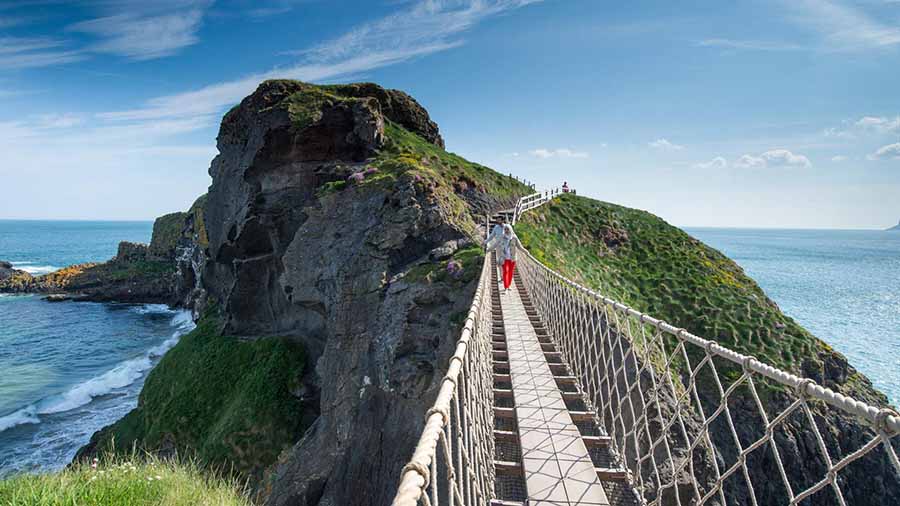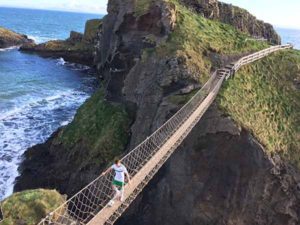
The Carrick-a-Rede Rope Bridge, located near Ballintoy in County Antrim, is one of Ireland’s most thrilling attractions, managed by the National Trust. Famous for its swaying rope bridge connecting the mainland to the tiny Carrick-a-Rede Island, it offers stunning coastal views and a rich historical narrative tied to salmon fishing.
What Visitors Can Expect at Carrick-a-Rede Rope Bridge
- Rope Bridge Crossing: The highlight is the 20-meter-long, 1-meter-wide rope bridge, suspended 30 meters (98 feet) above the Atlantic Ocean, connecting the mainland to Carrick-a-Rede Island. Originally erected by salmon fishermen in 1755, the current bridge, built in 2008 with wire rope and Douglas fir, is sturdy yet exhilarating, swaying slightly with the wind. Crossing takes about 30 seconds, with National Trust staff ensuring safety at both ends. Visitors often describe the experience as thrilling, especially on windy days, with breathtaking views of the Causeway Coastal Route, Rathlin Island, and the Scottish Isles. The bridge is not recommended for young children (under 8) due to safety concerns, and some visitors may need a boat to return if they lose nerve for the return crossing.
- Carrick-a-Rede Island: The island, a volcanic plug formed 60m years ago, features a single 400-year-old listed fisherman’s cottage, historically used for shelter and storage during the salmon fishing era (1620–2002). The cottage is typically closed but opens one weekend per month for guided tours by volunteers sharing stories of the fishery, which once netted up to 300 salmon daily. The island offers a short walk with panoramic views, though paths can be muddy and rocky, requiring caution.
- Coastal Walk: The 1km walk from the car park to the bridge takes about 20 minutes, featuring a scenic coastal path along the North Antrim Coast with windswept grasslands and cliffs. The path includes steep steps and uneven terrain, particularly the final descent to the bridge, requiring sturdy footwear (not flip-flops). The first 0.5km is wheelchair-accessible, with an accessible telescope for views. The walk offers opportunities to spot wildlife like guillemots, razorbills, kittiwakes, fulmars, basking sharks, dolphins, and porpoises.
- Historical Context: The bridge’s history is tied to salmon fishing, which began in 1620 and ended in 2002 due to declining salmon populations from overfishing and pollution. Visitors can see a recreated wooden crane (derrick) used to hoist fishing boats, adding to the site’s historical narrative. Informative plaques and occasional volunteer talks highlight the legacy of fishermen like Alex “Achi” Colgan, the last to fish here.
Visitor Logistics:
- Hours: Open daily (except Christmas Day and Boxing Day), typically 9:00 AM–5:00 PM, with extended summer hours (until 6:00 PM, July–August). The bridge may close in high winds for safety; check www.nationaltrust. org.uk for updates.
- Tickets: £13.50–£15.50 for adults, £6.75–£8.50 for children (under 5s free), family tickets available. National Trust members and local pass holders enter free but must pre-book. Bridge crossing tickets include parking; non-crossing visitors pay £10 for parking only. Pre-booking online is essential, especially in peak season (July–August), as slots sell out months in advance. Book at www.nationaltrust-tickets.org.uk or call +44 34 4249 1895. Cancellations or changes are possible up to 24 hours prior. On the B15, 7 miles east of Bushmills, 5 miles west of Ballycastle, 10 minutes from the Giant’s Causeway. Accessible by car (1.15 hours from Belfast), bus (Causeway Rambler #376 or Ulsterbus #252), or train to Coleraine then bus. Sat Nav: Lat. 55.239796, Long. -6.349012.
- A typical visit lasts 1–1.5 hours, including the walk, bridge crossing, island exploration, and café stop. The final daily slot allows 1.5 hours.
- Visitor Amenities: The Weighbridge Tea Room near the car park serves coffee, toasted sandwiches, and snacks (e.g., a sandwich costs £9.50, considered pricey by some). Toilets are available during car park hours, and a gift shop offers certificates for crossing the bridge and other souvenirs. Dogs are welcome on-site (on leads) but cannot cross the bridge.
- The first 0.5km of the coastal path is accessible, but the bridge and island are not due to steep steps and uneven terrain. A wheelchair is available to borrow (contact staff at +44 28 2076 1609). Campervans and motorhomes can park in limited spaces (first-come, first-served; no overnight parking). Accessible parking and toilets are provided.
- Visitor Feedback: Visitors praise the “exhilarating” bridge crossing and “stunning” coastal views, calling it a must-do for adventure seekers and nature lovers. The scenery, including Rathlin Island and the Scottish Isles, is a highlight, though some find the £15.50 adult ticket pricey for a 30-second crossing. Queues can be long (up to 30 minutes on busy days), and the café’s high prices draw criticism (e.g., £9.50 for a sandwich vs. cheaper options elsewhere). The walk’s steep steps and occasional muddy paths require preparation.

What’s New for 2025
- Wildflower Crown Making Workshop: The annual workshop led by Nature Engagement Officer Cliff Henry continues. Visitors can create wildflower crowns using local flora, enhancing the site’s focus on nature engagement. Check www.nationaltrust. org.uk for dates.
- Enhanced Booking System: Following high demand (485,736 visitors in 2018), the National Trust emphasizes pre-booking to manage crowds and reduce queue times. In 2025, expect improved online ticketing with clearer time slots, especially for early (9:00 AM–11:00 AM) and late (3:00 PM–5:00 PM) visits, which offer cheaper rates and quieter experiences. Campervan and coach bookings must be made 72 hours in advance via carrick-a-rede@nationaltrust. org.uk or +44 28 2073 3419.
- Conservation Focus: As a National Trust property in an Area of Special Scientific Interest, Carrick-a-Rede will introduce new interpretive signage or ranger-led talks in 2025 to highlight its unique geology (volcanic plug, dolerite cliffs) and wildlife (basking sharks, seabirds). These align with the Trust’s commitment to sustainability and education.
- Fisherman’s Cottage Open Days: The cottage’s monthly open days, featuring volunteer-led tours about the salmon fishery, are expected to continue in 2025. These will include new storytelling elements or exhibits about the crane and fishing history, building on the 2024 recreation of the derrick.
- Regional Tourism Integration: As part of the Causeway Coastal Route’s prominence in 2025 tourism campaigns (e.g., Tourism Ireland’s focus on the north’s coastal beauty), Carrick-a-Rede will feature in updated digital guides or apps, promoting nearby attractions like the Giant’s Causeway (7 miles away), Ballintoy Harbour, or Bushmills Distillery.
- In 2025, visitors to Carrick-a-Rede Rope Bridge can expect an adrenaline-pumping yet safe crossing over the Atlantic, with unparalleled views of the rugged coastline. The 1km coastal walk, historic fisherman’s cottage, and wildlife sightings add depth to the experience, making it ideal for adventure seekers, nature lovers, and families with older children. The Weighbridge Tea Room and gift shop provide convenience, though prices may feel steep. The Wildflower Crown Workshop and cottage open days offer new engagement opportunities, while improved ticketing aims to ease crowds. Visitors should pre-book tickets, wear sturdy shoes, and prepare for steep steps and potential wind or rain (waterproof clothing advised). Arriving early or late avoids peak congestion. Combine with the Giant’s Causeway or Ballintoy Harbour for a full day on the Causeway Coastal Route. For updates, check www.nationaltrust. org.uk or contact carrick-a-rede@nationaltrust. org.uk or +44 28 2073 3419.



